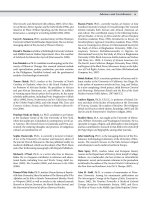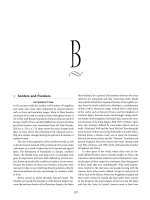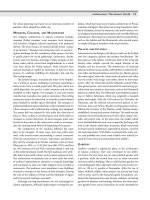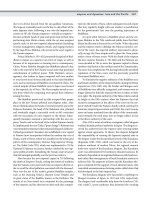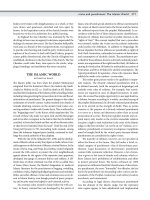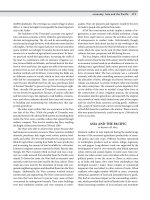Encyclopedia of society and culture in the medieval world (4 volume set) ( facts on file library of world history ) ( PDFDrive ) 861
Bạn đang xem bản rút gọn của tài liệu. Xem và tải ngay bản đầy đủ của tài liệu tại đây (73.15 KB, 1 trang )
834 religion and cosmology: Asia and the Pacific
scene of a figure impaled on stakes near a king’s burial site is
interpreted by some archaeologists as a punishment for failing to cure the monarch, though he may simply be a victim
dispatched to assist the king in the next life. We do not know
much about the divinities venerated by the Moche, though
supernatural beings with jaguar, reptile, and other animal
features appear in their art. A repeated pattern that archaeologists call the Confrontation Scene shows an armed hero
about to battle a mythic monster, perhaps an image of the
conflict between order and chaos.
Our knowledge of Inca religion relies, as for the Aztec,
on a combination of archaeological material and the writings
of conquistadors and missionaries after the Spanish invasion
of Peru in 1532. The conquerors’ writings are subject to the
same biases and distortion, and require the same caution
in reading, as are those on Aztec religion. Like other Native
Americans, the Inca divided the universe into upper world,
middle world, and underworld and viewed the Milky Way
as a world axis. Inca cosmology, however, places a somewhat
greater emphasis on the duality of complementary opposites
in the cosmos, reflected in dual social structures and dualities
in the realms of nature such as the Andes and the coast, the
earth and sky, and the sun and moon.
The supreme god of the Inca Empire was Inti, the sun god,
and the Incan rulers were viewed as his descendants, sons of
the sun. According to Incan legend, the first emperor and his
family were created by Inti at Tiwanaku in Bolivia, where the
gods themselves were born. The Inca dedicated their capital
city, Cuzco, to Inti, and his temple there was covered with
sheets of gold. As offerings to the sun they sacrificed llamas
(frequently) and humans (less frequently) and burned luxurious textiles considered highly valuable because of the intensive labor that went into their creation. Miniature gold and
silver images of humans, plants, animals, and even natural
phenomena were kept in the temple as symbolic representations of the empire offered to the deity.
Like the Aztec city of Tenochtitlán, Cuzco was not just
a political center but the actual axis or navel of the world. A
series of imaginary lines, called ceques, radiated out from this
central hub of the universe, dividing the empire into distinct
ritual zones. The ceques could also be traced by pilgrims and
priests over the landscape by reference to geographic features
viewed as sacred. Called huacas, these features could be natural, human made, or an integration of both, connoting objects charged with spiritual force. Unusual rock formations,
trees, springs, and mountains could all be huacas, as could
deity images and the mummies of venerated ancestors. In
the vicinity of Cuzco were 328 huacas, and many more were
scattered throughout the empire. Human sacrifice of children
aimed at promoting the integrity of the empire and the ruler’s
health took place at sacred areas as distant as islands off the
Ecuadorian coast and 13,000-foot Andean peaks in Argentina, all linked by radiating spiritual paths. The remains of
some of these sacrifices, frozen by the mountain climate, have
survived intact to be discovered by archaeologists.
As a vast empire of many conquered groups, the Inca
realm was home to many diverse religious traditions. Inti
and the creator god, Viracocha, were popular deities in the
Andean highlands, while on the desert north coast, where the
sun was less well regarded, moon and sea goddesses were favored by the Chimú and other conquered peoples. Predominated on the south coast were Pachamama, the earth goddess,
and Pachacamac, god of earthquakes. At a site of the same
name, Pachacamac had his own oracle whom pilgrims consulted before it was struck dumb by the arrival of the Spanish
in 1532. To keep their subjects in line, the Inca removed god
images and other huacas to Cuzco, to be held hostage in case
of potential rebellion.
Rivaling the gods and other huacas as objects of worship were human ancestors. The Inca kept the mummies of
important family members above ground or in open tombs
for continued contact and consultation by their descendants.
Mummies of royalty and their attendants could acquire sufficient power to threaten the influence of the living monarch,
a situation the last Inca emperor, Atahualpa, took measures
to correct.
Asia and the Pacific
by
Kenneth Hall
Asia’s medieval religions evolved from local animism (worship of spirits associated with the natural order) and ancestor
worship into new faiths that addressed a single universal divine. Like the Christian monotheistic tradition of the Trinity
(God the Father, Son, and Holy Spirit), the universal divine in
Asian religions might have more than one form of existence
or even many forms. Indian religions such as Hinduism and
Buddhism focus on humanity’s desire for a life after death. In
contrast, Chinese religions consider humanity’s place in the
world, whether in relation to the realm of nature (Daoism) or
in celebrating human relationships as they are essential to an
orderly and productive society (Confucianism).
Animism
Traditional Asian and Pacific island animism, widely practiced during the medieval era, was based on local belief in
spirits that populate the realm of nature and the realm of
humanity. These spirits were revealed in dreams, trances,
and a variety of supernatural experiences, including human
encounters in this world with ghosts or other spiritual pres-

